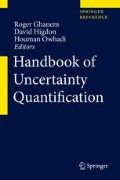Abstract
Parametric uncertainty, considered broadly to include uncertainty in system parameters and driving forces (source terms and initial and boundary conditions), is ubiquitous in mathematical modeling. The method of distributions, which comprises PDF and CDF methods, quantifies parametric uncertainty by deriving deterministic equations for either probability density function (PDF) or cumulative distribution function (CDF) of model outputs. Since it does not rely on finite-term approximations (e.g., a truncated Karhunen-Loève transformation) of random parameter fields, the method of distributions does not suffer from the “curse of dimensionality.” On the contrary, it is exact for a class of nonlinear hyperbolic equations whose coefficients lack spatiotemporal correlation, i.e., exhibit an infinite number of random dimensions.
Access this chapter
Tax calculation will be finalised at checkout
Purchases are for personal use only
References
Ambrosio, L., Fusco, N., Pallara, D.: Functions of Bounded Variation and Free Discontinuous Problems. The Clarendon Press/Oxford University Press, Oxford/New York (2000)
Arnold, L.: Random Dynamical Systems. Springer, Berlin/New York (1998)
Benabdallahh, A., Serre, D.: Problèmes aux limites pour des systèmes hyperboliques non linéaires de deux équations à une dimension d’espace. C. R. Acad. Sci. Paris 305, 677–680 (1986)
Bharucha-Reid, A.T. (ed.): Probabilistic Methods in Applied Mathematics. Academic, New York (1968)
Boso, F., Broyda, S.V., Tartakovsky, D.M.: Cumulative distribution function solutions of advection-reaction equations with uncertain parameters. Proc. R. Soc. A 470(2166), 20140189 (2014)
Broyda, S., Dentz, M., Tartakovsky, D.M.: Probability density functions for advective-reactive transport in radial flow. Stoch. Environ. Res. Risk Assess. 24(7), 985–992 (2010)
Dubois, F., LeFLoch, P.: Boundary conditions for nonlinear hyperbolic systems. J. Differ. Equ. 71, 93–122 (1988)
Evans, L.C.: Partial Differential Equations, 2nd edn. AMS, Providence (2010)
Fox, R.F.: Functional calculus approach to stochastic differential equations. Phys. Rev. A 33, 467–476 (1986)
Fuentes, M.A., Wio, H.S., Toral, R.: Effective Markovian approximation for non-Gaussian noises: a path integral approach. Physica A 303(1–2), 91–104 (2002)
Gisclon, M.: Etude des conditions aux limites pour un système strictement hyperbolique via l’approximation parabolique. PhD thesis, Université Claude Bernard, Lyon I (France) (1994)
Gisclon, M., Serre, D.: Etude des conditions aux limites pour un système strictement hyperbolique via l’approximation parabolique. C. R. Acad. Sci. Paris 319, 377–382 (1994)
H\(\ddot{\mbox{ a}}\) nggi, P., Jung, P.: Advances in Chemical Physics, chapter Colored Noise in Dynamical Systems, pp. 239–326. John Wiley & Sons, New York (1995)
Kozin, F.: On the probability densities of the output of some random systems. Trans. ASME Ser. E J. Appl. Mech. 28, 161–164 (1961)
Kurganov, A., Lin, C.-T.: On the reduction of numerical dissipation in central-upwind schemes. Commun. Comput. Phys. 2, 141–163 (2007)
Kurganov, A., Noelle, S., Petrova, G.: Semi-discrete central-upwind scheme for hyperbolic conservation laws and hamilton-jacobi equations. SIAM J. Sci. Comput. 23, 707–740 (2001)
Kurganov, A., Petrova, G.: A third order semi-discrete genuinely multidimensional central scheme for hyperbolic conservation laws and related problems. Numer. Math. 88, 683–729 (2001)
Kurganov, A., Tadmor, E.: New high-resolution central schemes for nonlinear conservation laws and convection-diffusion equations. J. Comput. Phys. 160, 241–282 (2000)
Lichtner, P.C., Tartakovsky, D.M.: Stochastic analysis of effective rate constant for heterogeneous reactions. Stoch. Environ. Res. Risk Assess. 17(6), 419–429 (2003)
Lindenberg, K., West, B.J.: The Nonequilibrium Statistical Mechanics of Open and Closed Systems. VCH Publishers, New York (1990)
Lundgren, T.S.: Distribution functions in the statistical theory of turbulence. Phys. Fluids 10(5), 969–975 (1967)
Risken, H.: The Fokker-Planck Equation: Methods of Solutions and Applications, 2nd edn. Springer, Berlin/New York (1989)
Tartakovsky, D.M., Broyda, S.: PDF equations for advective-reactive transport in heterogeneous porous media with uncertain properties. J. Contam. Hydrol. 120–121, 129–140 (2011)
Tartakovsky, D.M., Dentz, M., Lichtner, P.C.: Probability density functions for advective-reactive transport in porous media with uncertain reaction rates. Water Resour. Res. 45, W07414 (2009)
Venturi, D., Karniadakis, G.E.: New evolution equations for the joint response-excitation probability density function of stochastic solutions to first-order nonlinear PDEs. J. Comput. Phys. 231(21), 7450–7474 (2012)
Venturi, D., Karniadakis, G.E.: Differential constraints for the probability density function of stochastic solutions to wave equation. Int. J. Uncertain. Quant. 2, 195–213 (2012)
Venturi, D., Sapsis, T.P., Cho, H., Karniadakis, G.E.: A computable evolution equation for the joint response-excitation probability density function of stochastic dynamical systems. Proc. R. Soc. A 468(2139), 759–783 (2012)
Venturi, D., Tartakovsky, D.M., Tartakovsky, A.M., Karniadakis, G.E.: Exact PDF equations and closure approximations for advective-reactive transport. J. Comput. Phys. 243, 323–343 (2013)
Wang, P., Tartakovsky, A.M., Tartakovsky, D.M.: Probability density function method for Langevin equations with colored noise. Phys. Rev. Lett. 110(14), 140602 (2013)
Wang, P., Tartakovsky, D.M.: Uncertainty quantification in kinematic-wave models. J. Comput. Phys. 231(23), 7868–7880 (2012)
Wang, P., Tartakovsky, D.M., Jarman K.D. Jr., Tartakovsky, A.M.: CDF solutions of Buckley-Leverett equation with uncertain parameters. Multiscale Model. Simul. 11(1), 118–133 (2013)
Xiu, D., Karniadakis, G.E.: The Wiener-Askey polynomial chaos for stochastic differential equations. SIAM J. Sci. Comput. 24, 619–644 (2002)
Author information
Authors and Affiliations
Corresponding author
Editor information
Editors and Affiliations
Appendix
Appendix
It follows from (22.11) and the fact that u solves (22.10) that
for any \(\phi \in \mathcal{ C\,}_{c}^{1}(\mathbb{R}^{N} \times [0,\infty ))\). Therefore
Integration by parts in U yields
By the above definition of I, we have established that, for any \(\phi \in \mathcal{ C\,}_{c}^{1}(\mathbb{R}^{N} \times [0,\infty ))\),
Using standard arguments [1], taking the limit 𝜖 → 0 leads to (22.12).
Rights and permissions
Copyright information
© 2017 Springer International Publishing Switzerland
About this entry
Cite this entry
Tartakovsky, D.M., Gremaud, P.A. (2017). Method of Distributions for Uncertainty Quantification. In: Ghanem, R., Higdon, D., Owhadi, H. (eds) Handbook of Uncertainty Quantification. Springer, Cham. https://doi.org/10.1007/978-3-319-12385-1_27
Download citation
DOI: https://doi.org/10.1007/978-3-319-12385-1_27
Published:
Publisher Name: Springer, Cham
Print ISBN: 978-3-319-12384-4
Online ISBN: 978-3-319-12385-1
eBook Packages: Mathematics and StatisticsReference Module Computer Science and Engineering

